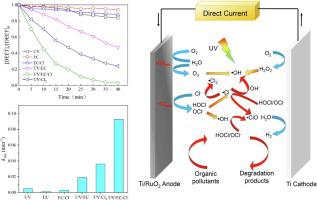Separation and Purification Technology ( IF 8.1 ) Pub Date : 2022-01-10 , DOI: 10.1016/j.seppur.2022.120465 Jia-Ying Li 1 , Rui Hu 1 , Lili Shan 1, 2 , Zheng-Qian Liu 1, 3 , Sui-Qin Yang 1 , Jingjing Yang 4 , Fengyi Sun 1 , Yu-Hong Cui 1

|
The performance of ultraviolet combined electrochemical (EC) process for treating chloride-containing (UV/EC/Cl-) solution was evaluated based on the N, N-Diethyl-m-toluamide (DEET) degradation. The influences of operating conditions and water matrix on the DEET degradation were investigated, and the reaction mechanism of UV/EC/Cl- process was discussed based on the analysis of DEET degradation pathway, the detection of the steady-state concentrations of active free radicals and the analysis of free radicals scavenging. The observed reaction rate constant of DEET degradation in UV/EC/Cl- process (0.093 min−1) is significantly higher than that of UV/Cl2 process (0.036 min−1), and the synergistic effect on the DEET degradation is remarkable in UV/EC/Cl- process. The current and chloride concentration have remarkable impact on the DEET degradation, while the initial pH, reaction temperature, and initial DEET concentration have slight influence on the DEET degradation. The impact of alkalinity on DEET degradation is more significant than that of ammonia, while sulfate and phosphate have slight effect on the DEET degradation. The active points attacked by free radicals on DEET molecule were predicted basing on density functional theory. During the DEET degradation, small molecular products are produced through a series of reactions such as hydrogen abstraction, substitution, dealkylation, and ring-opening. The steady-state concentrations of HO• and Cl• in UV/EC/Cl- process (1.57 × 10-13 M and 2.37 × 10-14 M, respectively) are higher than those of UV/Cl2 process (1.23 × 10-13 M and 1.07 × 10-14 M, respectively), and HO• and Cl• play key roles in the DEET degradation during the UV/EC/Cl- process.
中文翻译:

操作条件和水基质对紫外联合电化学工艺处理含氯溶液性能的影响及其反应机理
基于N,N-二乙基-间甲苯酰胺(DEET)降解评价了紫外联合电化学(EC)工艺处理含氯(UV/EC/Cl - )溶液的性能。考察了操作条件和水基质对避蚊胺降解的影响,在对避蚊胺降解途径分析、活性自由基稳态浓度检测的基础上,探讨了UV/EC/Cl-过程的反应机理。以及清除自由基的分析。观察到UV/EC/Cl -过程中DEET降解的反应速率常数(0.093 min -1)明显高于UV/Cl 2过程(0.036 min -1),并且在UV/EC/Cl-过程中对DEET降解的协同作用是显着的。电流和氯化物浓度对避蚊胺降解有显着影响,而初始pH、反应温度和避蚊胺初始浓度对避蚊胺降解影响较小。碱度对避蚊胺降解的影响比氨水更显着,而硫酸盐和磷酸盐对避蚊胺降解的影响较小。基于密度泛函理论预测了自由基对避蚊胺分子的攻击活性点。在避蚊胺降解过程中,通过夺氢、取代、脱烷基化、开环等一系列反应生成小分子产物。H2O •和Cl的稳态浓度•在UV/EC/Cl -工艺中(分别为1.57 × 10 -13 M 和2.37 × 10 -14 M)高于UV/Cl 2工艺(1.23 × 10 -13 M 和1.07 × 10 -14 M ) , 分别),HO •和Cl •在UV/EC/Cl -过程中的DEET 降解中起关键作用。











































 京公网安备 11010802027423号
京公网安备 11010802027423号